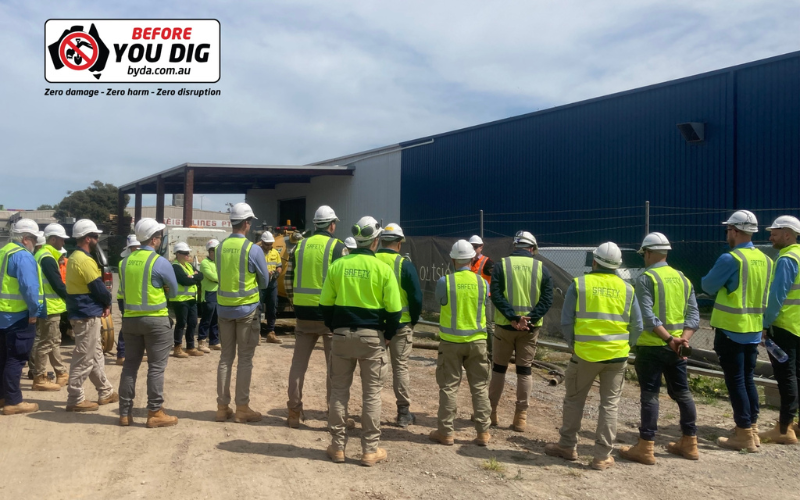Australia’s utility networks are vital, powering homes, businesses, and critical infrastructure that keeps the country running. But these essential networks are under constant threat, with over 1,100 strikes each month caused by construction and excavation activities. The implications of utility damage extend far beyond immediate repair costs, with flow-on effects impacting individuals, businesses, and communities. Often, the ripple effect sees costs soar, with ratios as high as 1:29.
Before You Dig Australia (BYDA) is at the forefront of addressing this escalating challenge. Through collaboration with industries, utility owners, and the construction sector, BYDA plays a pivotal leadership role in ensuring the safety of both workers and infrastructure. Together, we have the opportunity to change the trajectory and secure Australia’s utility networks for the future.
Leading the Charge on a Growing Problem
Australia’s utility networks, spanning electricity, gas, water, and telecommunications, are critical to everyday life, but face growing risks. Each year, thousands of preventable underground and above-ground utility strikes occur, resulting in service disruptions, costly repairs, and, tragically, sometimes loss of life.
Our data shows that over 13,000 utility strikes occur annually, costing millions in immediate repairs. However, the broader financial impact is far greater, affecting insurance premiums, economic productivity, and business operations. This problem isn’t limited to one sector or community; it is a challenge impacting us all.
This is where leadership and collaboration become essential. As stakeholders across industries, we must take a more proactive stance to protect Australia’s critical infrastructure and safeguard the people who work with and depend on it every day.
The Hidden Costs of Utility Strikes: More Than Just Infrastructure Damage
While the direct costs of repairing damaged infrastructure are significant, the hidden financial and human costs are even more alarming. A single utility strike can cause service outages that disrupt businesses, lead to missed deadlines, and reduce overall productivity. These disruptions don’t just impact a single project—they can ripple through supply chains, affect customer trust, and hurt the economy.
Increased insurance premiums and operational costs are further consequences, placing an additional burden on businesses. But the most important consideration is the human cost. Utility damage can result in serious injuries or fatalities, and the emotional toll on workers, families, and communities is immeasurable.
This makes it clear: preventing utility strikes is not just about protecting assets; it’s about saving lives.

BYDA’s Role: Collaborative Safety Solutions
Addressing this challenge requires strong leadership, and BYDA is leading the charge. By providing critical safety tools and fostering industry-wide collaboration, BYDA helps ensure workers and businesses across Australia can operate safely and efficiently.
One of BYDA’s key offerings is the free referral service, which provides access to underground utility plans and safety guidelines. This service allows workers to plan with precision, reducing the risk of strikes and ensuring the safety of everyone involved. Accessible online and via mobile apps, this resource ensures that vital safety information is at workers’ fingertips, no matter where they are.
The addition of the Look Up and Live tool further enhances this service, providing real-time, map-based information on above-ground utilities. By making it easy to access information about both underground and overhead assets, BYDA is empowering workers to take the necessary precautions to avoid potentially life-threatening strikes. You can explore the capabilities of this tool at www.lookupandlive.com.
Collaboration Through Education and Training
Addressing the problem requires more than just tools—we need a shift in mindset and culture. That’s why BYDA offers free training and education programs to raise awareness about safe work practices and promote a culture of safety within the industry.
These programs equip workers with the skills and knowledge to identify potential hazards and take steps to avoid them. Investing in education prevents damage and empowers a new generation of workers to prioritise safety. This collaboration between BYDA and the industry ensures that safety becomes a shared responsibility—a core value that drives every decision and every project.
Economic Impact Research: Driving Industry Collaboration for Change
BYDA’s commitment to collaboration extends beyond day-to-day safety tools and training. In 2024, we will publish the results of independent economic research aimed at quantifying the broader costs of utility strikes on Australian communities. This research will shine a light on the far-reaching consequences of these incidents and make a compelling case for industry-wide collaboration to reduce the frequency of strikes.
As part of this call to action, we will bring together leaders from the construction sector, utilities, and regulatory bodies to develop a meaningful, long-term solution. We need to challenge the status quo and explore innovative approaches—whether it’s through improved digital data sharing, enhanced safety protocols, or more robust training programs—to reduce utility strikes and protect both people and infrastructure.
Zero damage, zero harm, and zero disruption are the goals we must collectively strive for. Achieving these outcomes will require leadership, commitment, and collaboration across industries.
A Trusted Leader in Safety
As Australia’s leading voice in utility damage prevention, BYDA is committed to driving change. Through collaboration with industry partners and a relentless focus on safety, we are working to protect the vital infrastructure that underpins our economy and communities.
It’s time for every business, every project, and every worker to embrace a culture of safety and protect the lives and assets that are critical to Australia’s future. Visit BYDA today and equip your teams with the knowledge and tools needed to operate safely and effectively. Together, through leadership and collaboration, we can build a safer future for Australia’s workers and utility networks.














